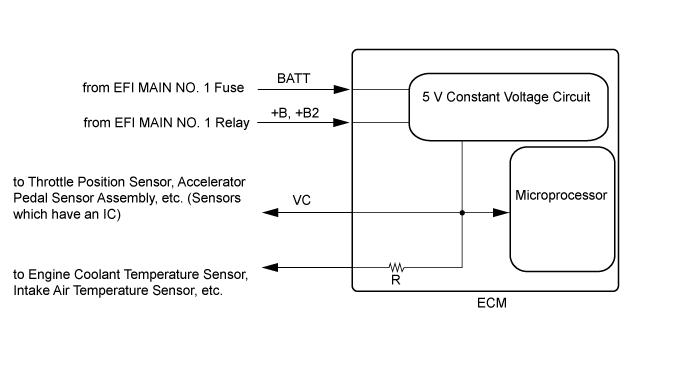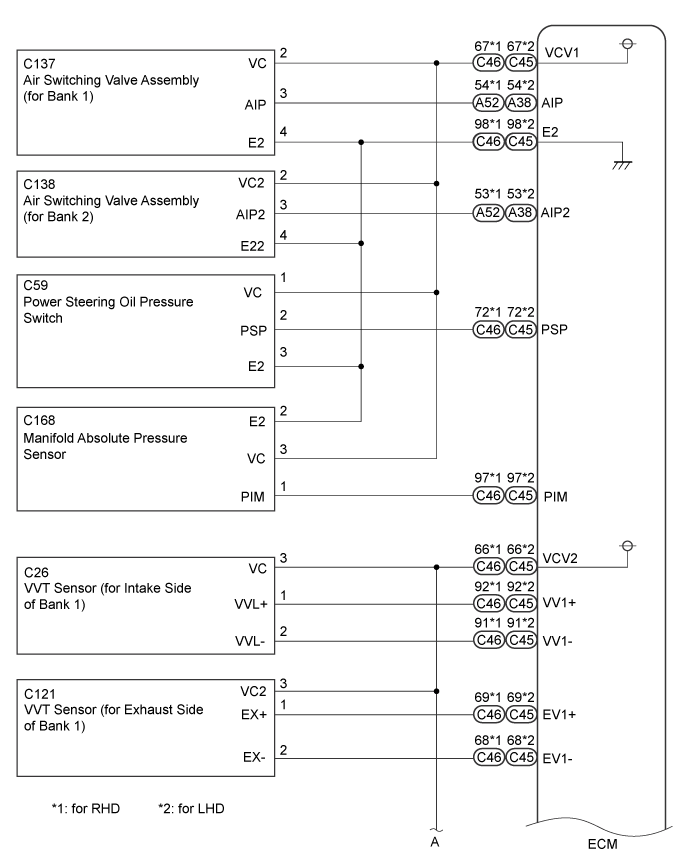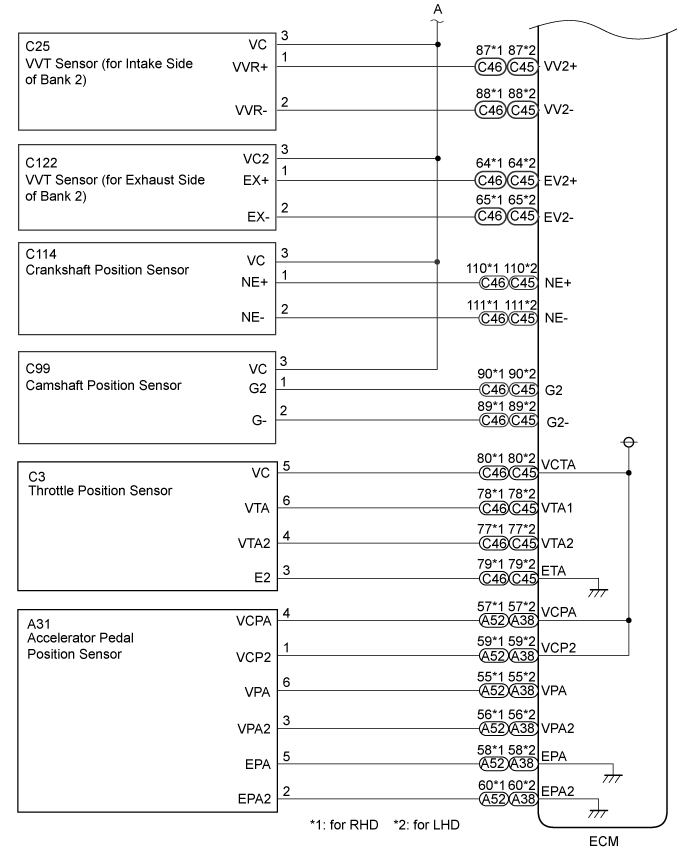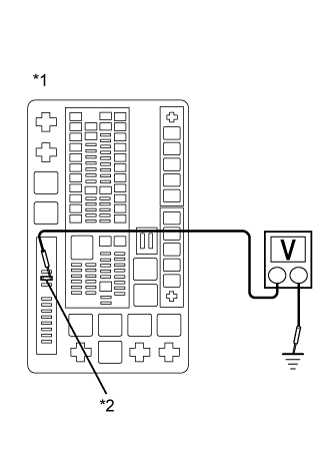CHECK TERMINAL VOLTAGE (POWER SOURCE OF ECM)
CHECK CONNECTION BETWEEN GTS AND ECM (THROTTLE POSITION SENSOR)
CHECK CONNECTION BETWEEN GTS AND ECM (ACCELERATOR PEDAL POSITION SENSOR)
CHECK CONNECTION BETWEEN GTS AND ECM (MANIFOLD ABSOLUTE PRESSURE SENSOR)
CHECK CONNECTION BETWEEN GTS AND ECM (AIR SWITCHING VALVE for Bank 1)
CHECK CONNECTION BETWEEN GTS AND ECM (AIR SWITCHING VALVE for Bank 2)
CHECK CONNECTION BETWEEN GTS AND ECM (POWER STEERING OIL PRESSURE SENSOR)
CHECK CONNECTION BETWEEN GTS AND ECM (CAMSHAFT POSITION SENSOR)
CHECK CONNECTION BETWEEN GTS AND ECM (CRANKSHAFT POSITION SENSOR)
CHECK CONNECTION BETWEEN GTS AND ECM (VVT SENSOR for Intake Side of Bank 1)
CHECK CONNECTION BETWEEN GTS AND ECM (VVT SENSOR for Exhaust Side of Bank 1)
CHECK CONNECTION BETWEEN GTS AND ECM (VVT SENSOR for Intake Side of Bank 2)
CHECK CONNECTION BETWEEN GTS AND ECM (VVT SENSOR for Exhaust Side of Bank 2)
SFI SYSTEM - VC Output Circuit |
DESCRIPTION
The ECM constantly generates 5 V power from the battery voltages supplied to the +B (BATT) terminal to operate the microprocessor. The ECM also provides this power to the sensors through the VC output circuit.
When the VC circuit is short-circuited, the microprocessor in the ECM and sensors that are supplied with power through the VC circuit are inactivated because the power is not supplied from the VC circuit. Under this condition, the system does not start up and the MIL does not illuminate even if the system malfunctions.
WIRING DIAGRAM
- Refer to ECM Power Source Circuit (Click here).
- VC Output Circuit


INSPECTION PROCEDURE
- NOTICE:
- Inspect the fuses for circuits related to this system before performing the following inspection procedure.
| 1.READ VALUE USING GTS |
Connect the GTS to the DLC3.
Turn the engine switch on (IG) and GTS on.
Check the communication between the GTS and ECM.
- HINT:
- It can be checked using the "Engine" item of the Data List.
Result Result Proceed to Communication is not possible A Communication is possible B
|
| ||||
| A | |
| 2.CHECK TERMINAL VOLTAGE (POWER SOURCE OF ECM) |
Turn the engine switch on (IG).
 |
Measure the voltage according to the value(s) in the table below.
- Standard Voltage:
Tester Connection Condition Specified Condition 1 (EFI No. 2 fuse) - Body ground Engine switch on (IG) 11 to 14 V
Text Illustration *1 Engine Room Relay Block *2 EFI No. 2 Fuse - HINT:
- If the result is not as specified, since current is not flowing to the +B and +B2 terminals of the ECM, the system may not be started.
|
| ||||
| OK | |
| 3.CHECK CONNECTION BETWEEN GTS AND ECM (THROTTLE POSITION SENSOR) |
Disconnect the throttle body connector.
Turn the engine switch on (IG).
Turn the GTS on.
Check the communication between the GTS and ECM.
- HINT:
- It can be checked using the "Engine and ECT" item of the Data List.
Result Result Proceed to Communication is not possible A Communication is possible B
|
| ||||
| A | |
| 4.CHECK CONNECTION BETWEEN GTS AND ECM (ACCELERATOR PEDAL POSITION SENSOR) |
Disconnect the accelerator pedal position sensor connector.
Turn the engine switch on (IG).
Turn the GTS on.
Check the communication between the GTS and ECM.
- HINT:
- It can be checked using the "Engine and ECT" item of the Data List.
Result Result Proceed to Communication is not possible A Communication is possible B
|
| ||||
| A | |
| 5.CHECK CONNECTION BETWEEN GTS AND ECM (MANIFOLD ABSOLUTE PRESSURE SENSOR) |
Disconnect the manifold absolute pressure sensor connector.
Turn the engine switch on (IG).
Turn the GTS on.
Check the communication between the GTS and ECM.
- HINT:
- It can be checked using the "Engine and ECT" item of the Data List.
Result Result Proceed to Communication is not possible A Communication is possible B
|
| ||||
| A | |
| 6.CHECK CONNECTION BETWEEN GTS AND ECM (AIR SWITCHING VALVE for Bank 1) |
Disconnect the air switching valve (for Bank 1) connector.
Turn the engine switch on (IG).
Turn the GTS on.
Check the communication between the GTS and ECM.
- HINT:
- It can be checked using the "Engine and ECT" item of the Data List.
Result Result Proceed to Communication is not possible A Communication is possible B
|
| ||||
| A | |
| 7.CHECK CONNECTION BETWEEN GTS AND ECM (AIR SWITCHING VALVE for Bank 2) |
Disconnect the air switching valve (for Bank 2) connector.
Turn the engine switch on (IG).
Turn the GTS on.
Check the communication between the GTS and ECM.
- HINT:
- It can be checked using the "Engine and ECT" item of the Data List.
Result Result Proceed to Communication is not possible A Communication is possible B
|
| ||||
| A | |
| 8.CHECK CONNECTION BETWEEN GTS AND ECM (POWER STEERING OIL PRESSURE SENSOR) |
Disconnect the power steering oil pressure sensor connector.
Turn the engine switch on (IG).
Turn the GTS on.
Check the communication between the GTS and ECM.
- HINT:
- It can be checked using the "Engine and ECT" item of the Data List.
Result Result Proceed to Communication is not possible A Communication is possible B
|
| ||||
| A | |
| 9.CHECK CONNECTION BETWEEN GTS AND ECM (CAMSHAFT POSITION SENSOR) |
Disconnect the camshaft position sensor connector.
Turn the engine switch on (IG).
Turn the GTS on.
Check the communication between the GTS and ECM.
- HINT:
- It can be checked using the "Engine and ECT" item of the Data List.
Result Result Proceed to Communication is not possible A Communication is possible B
|
| ||||
| A | |
| 10.CHECK CONNECTION BETWEEN GTS AND ECM (CRANKSHAFT POSITION SENSOR) |
Disconnect the crankshaft position sensor connector.
Turn the engine switch on (IG).
Turn the GTS on.
Check the communication between the GTS and ECM.
- HINT:
- It can be checked using the "Engine and ECT" item of the Data List.
Result Result Proceed to Communication is not possible A Communication is possible B
|
| ||||
| A | |
| 11.CHECK CONNECTION BETWEEN GTS AND ECM (VVT SENSOR for Intake Side of Bank 1) |
Disconnect the VVT sensor (for Intake Side of Bank 1) connector.
Turn the engine switch on (IG).
Turn the GTS on.
Check the communication between the GTS and ECM.
- HINT:
- It can be checked using the "Engine and ECT" item of the Data List.
Result Result Proceed to Communication is not possible A Communication is possible B
|
| ||||
| A | |
| 12.CHECK CONNECTION BETWEEN GTS AND ECM (VVT SENSOR for Exhaust Side of Bank 1) |
Disconnect the VVT sensor (for Exhaust Side of Bank 1) connector.
Turn the engine switch on (IG).
Turn the GTS on.
Check the communication between the GTS and ECM.
- HINT:
- It can be checked using the "Engine and ECT" item of the Data List.
Result Result Proceed to Communication is not possible A Communication is possible B
|
| ||||
| A | |
| 13.CHECK CONNECTION BETWEEN GTS AND ECM (VVT SENSOR for Intake Side of Bank 2) |
Disconnect the VVT sensor (for Intake Side of Bank 2) connector.
Turn the engine switch on (IG).
Turn the GTS on.
Check the communication between the GTS and ECM.
- HINT:
- It can be checked using the "Engine and ECT" item of the Data List.
Result Result Proceed to Communication is not possible A Communication is possible B
|
| ||||
| A | |
| 14.CHECK CONNECTION BETWEEN GTS AND ECM (VVT SENSOR for Exhaust Side of Bank 2) |
Disconnect the VVT sensor (for Exhaust Side of Bank 2) connector.
Turn the engine switch on (IG).
Turn the GTS on.
Check the communication between the GTS and ECM.
- HINT:
- It can be checked using the "Engine and ECT" item of the Data List.
Result Result Proceed to Communication is not possible A Communication is possible B
|
| ||||
| A | |
| 15.CHECK HARNESS AND CONNECTOR |
Disconnect the throttle body connector.
Disconnect the accelerator pedal position sensor connector.
Disconnect the air switching valve connector (for Bank 1).
Disconnect the air switching valve connector (for Bank 2).
Disconnect the power steering oil pressure switch connector.
Disconnect the camshaft position sensor connector.
Disconnect the crankshaft position sensor connector.
Disconnect the VVT sensor (for Intake Side of Bank 1) connector.
Disconnect the VVT sensor (for Exhaust Side of Bank 1) connector.
Disconnect the VVT sensor (for Intake Side of Bank 2) connector.
Disconnect the VVT sensor (for Exhaust Side of Bank 2) connector.
Disconnect the manifold absolute pressure sensor connector.
Disconnect the ECM connectors.
Measure the resistance according to the value(s) in the table below.
- Standard Resistance:
for RHD Tester Connection Condition Specified Condition C46-80 (VCTA) - Body ground Always 10 kΩ or higher A52-57 (VCPA) - Body ground Always 10 kΩ or higher A52-59 (VCP2) - Body ground Always 10 kΩ or higher C46-66 (VCV2) - Body ground Always 10 kΩ or higher C46-67 (VCV1) - Body ground Always 10 kΩ or higher 1S-11 - A52-3 (+B) Always Below 1 Ω 1S-11 - A52-2 (+B2) Always Below 1 Ω 1S-11 or A52-3 (+B) - Body ground Always 10 kΩ or higher 1S-11 or A52-2 (+B2) - Body ground Always 10 kΩ or higher for LHD Tester Connection Condition Specified Condition C45-80 (VCTA) - Body ground Always 10 kΩ or higher A38-57 (VCPA) - Body ground Always 10 kΩ or higher A38-59 (VCP2) - Body ground Always 10 kΩ or higher C45-66 (VCV2) - Body ground Always 10 kΩ or higher C45-67 (VCV1) - Body ground Always 10 kΩ or higher 1S-11 - A38-3 (+B) Always Below 1 Ω 1S-11 - A38-2 (+B2) Always Below 1 Ω 1S-11 or A38-3 (+B) - Body ground Always 10 kΩ or higher 1S-11 or A38-2 (+B2) - Body ground Always 10 kΩ or higher
|
| ||||
| OK | ||
| ||